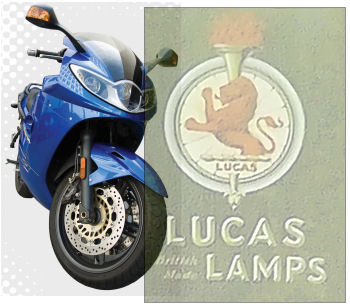 Ghost
of Lucas Ghost
of Lucas
2006 Sprint 1050ST Charging System
Anyone who's dealt with vintage British cars or bikes knows the name Lucas.
They also know the various nicknames, such as Prince of Darkness, or any
number of pithy one-liners including:
- The Lucas motto: "Get home before dark."
- Lucas is the patent holder for the short circuit.
- Lucas - Inventor of the first intermittent wiper.
- Lucas - Inventor of the self-dimming headlamp.
- Lucas Electrics - The Original Anti-Theft Device
- Q: Why do the British drink warm beer? A: Because Lucas makes their
refrigerators
Lucas is no longer (TRW owns the trademark and licenses it to
manufacturers of aftermarket parts) and modern Hinkley-built Triumphs, like
most motorcycles in the Age of the Global Economy, use Japanese
electrical bits, which should mean that the jar or Lucas Magic Smoke you
keep on the shelf can stay on the shelf. However, as the owner of
several modern Triumphs who rides with several modern Triumph owners, I
believe the ghost of Joseph Lucas may still haunt the British motorbike
industry.
|
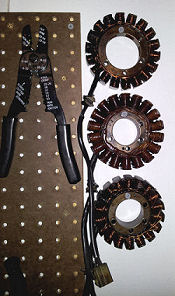
The Wall of Shame |
I'm sure the factory would deny that there is any problem, but I have
replaced three stators - 1050 Speed Triple, 1050 Sprint and 600cc Speed Four
- and a regulator/rectifier. People I ride with have also had stator issues,
with one bike going through several.
The simple Mr. Wizard-y description of a stator is that it's a big coiled
up wire. When put inside a spinning magnet (the rotor - on accounta it
spins whilst the stator stays put, get it?), electrons flow through the wire, charging your battery. The
actual motorcycle application is a little more complicated, but the basic
principle is middle-school science-fair stuff, and generally stators do not
fail. Except on Triumphs.
The failure is usually due to overheating. The wires cook and lose
conductivity or break altogether. The stators in the photo below are from the Speed Four
(left) and Sprint. You can see the crispy bits Notice that the Sprint stator
has coated wires, but you can still see the darkened portion there at the
top. It got completely black when exposed to the air for a while.
Stators can fail when the voltage regulator/rectifier - thus named
because it is a gizmo which
takes the electricity generated by the stator (as much as 20 volts depending
on how fast the engine is spinning) and regulates it to around 13-14 volts
so that the battery doesn't overcook, as well as rectifying it from alternating
current to battery-friendly direct current - fails. The unregulated
electricity can cause both stator and battery to overheat. However, in my
cases, the regulators were fine. I did notice that the burned bits of the stator were
always in the same place - about the 10 o'clock position. The stator is
cooled by engine oil. I think there's an oil flow issue and that area of the
stator does not get enough. I'm sure Triumph's esteemed engine designers would disagree.
I'm also pretty sure that the designers have probably never had to
actually work on a bike, but that's another story.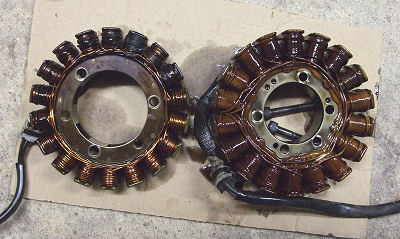
If you're lucky, this is all covered under warranty. If you're like the
rest of us, the stator expires a month after the warranty does. OEM Triumph
stators are $565. Regulator/rectifiers are $229. Add two to four hours of
shop time for diagnosis and replacement, plus $27 for a new gasket for the stator
cover and you're looking at over a grand easy.
Fortunately the problem isn't that difficult to diagnose. You'll need a
decent multimeter, available from
$5.49 for a basic, cheesy Harbor Freight
unit on sale to several hundred
for a fancy Fluke® meter. There are a bunch of
features and options and the knobs and dials and buttons can be confusing,
but it's not that hard to figure out. There are also all kinds of opinions
on what's best. Mine is digital and auto-ranging on accounta the digital
meters are easy to read and the auto-ranging feature means I do not have to
think as much. If I was working on
equipment for the International Space Station, I might want something
fancier but it gets the job done on motorcycles.
Some smart person put up a really good rundown on the diagnostic
routine
here on the Triumph forum. It's quite detailed and quite handy. The
short version is: Check the battery to see that it's good. If it is,
turn the bike on and see if the charging system is working - pretty easy
to tell, since you'll see the voltage rise with the revs. If it isn't
charging,
there are some simple resistance checks to run on the stator and regulator/rectifier
(hereafter referred to as R/R because "regulator/rectifier" takes too
long to type). See the link for details.
Of
course, you can also just take off the stator cover to see if it's gone
black and crunchy. On the Sprint, that means taking apart the Chinese
puzzle that is the fairing, and sacrificing a $26.95 stator cover
gasket, but you're going to have to do that anyway because trust me, the
stator's fried. It's a simple job. Just make sure you put some newspaper
or cardboard down, because there will be some oil spilling out when the
cover comes off. The stator itself is held to the cover with a couple of
bolts and the unit plugs into a connector on the regulator.
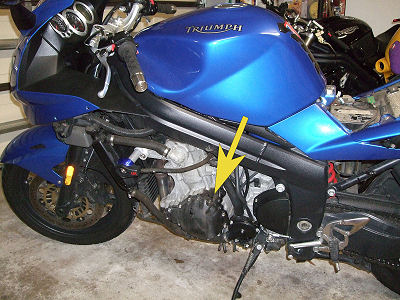
In ancient times, you could actually find shops that would rewind
stators. Maybe you live in an area where this black art is still
practiced, or better yet you want to get some copper wire and try it
yourself. Some brave souls do, and a few even succeed. But if you want to save the hassle and save a few hundred
bucks, get a stator from
Rick's Motorsport Electrics for half the price of OEM. They are generally
better quality too.
I opted to replace the R/R as well. Bear with me here
while I digress...
Here's the stock R/R.
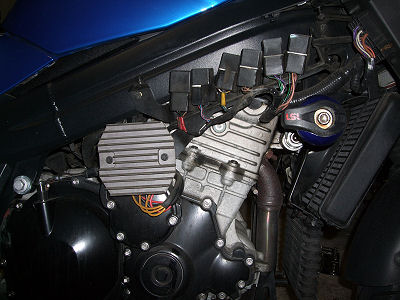
Voltage Regulator/Rectifiers are solid-state units
with a bunch of diodes and stuff to make the electrons behave in the proper
manner to assure the reliable function of the motorbike. These units are
sensitive sensitive to heat - hence the cooling fins - and can fail if they
get too hot.
Which is why it makes no sense to put it inside the
fairing, next to the engine, near the exhaust, directly in the path of the
hot air coming from the radiator in the front and going out the fairing
vents, which are just behind the R/R.
But that's where they put it. Probably because they do
not have to actually work on the machines they design.
Anyway... I replaced the stock R/R with one from
Rick's which is designed for slightly more charging voltage. Rick's
instructions say to cut the plug off of the leads where the stator connects
to the R/R and join the wires directly. Being lazy, since the connectors
worked I used them instead. That's the connector there at the top of the new R/R.
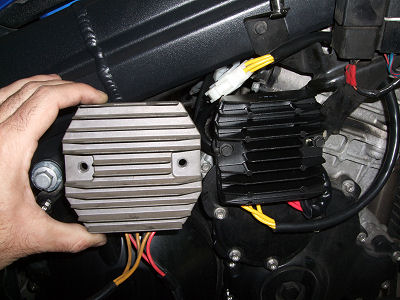
A few weeks later I was washing the bike. Some people
have constructed entire philosophies around the issue of washing bikes,
based on the First Principle which postulates that if you are washing, you are not
riding. Ergo you are therefore less of a motorcyclist. A dirty bike, then, is a
point of pride.
While I understand, I disagree. MotoGP teams have
people whose sole job is to clean the bike, not because they cannot ride,
but because in the process of cleaning, you often discover issues that need
to be addressed. And a clean bike is easier to work on. As I was washing the
Sprint, I noticed this inside the fairing.
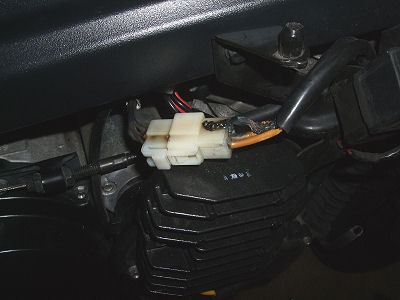
Obviously, one of the wires was overheating. This isn't entirely unusual.
There's a lot of electricity flowing through that connector and if the
connection isn't solid they can overheat. In the smaller pictures here, from
the Triumph forum, you can see connectors from other bikes. One is a 955
Sprint, the other a 955 Tiger.
I cut off the connector and cut back to good, clean wire, but before I
did so, I marked which wires went together. In theory, any of the three wires from the stator should connect to the
three wires to the R/R and things should function, but I'd rather not chance
anything. I marked the wires using a Sharpie - one, two and three
lines.
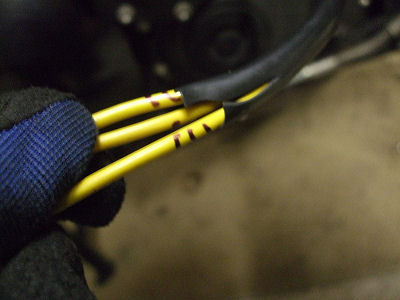
Then I cut the connectors off. I had to pry them apart - inside was a
burned, melted mess. I'm surprised the charging system was still working.
Another day or two of riding and it wouldn't have been.
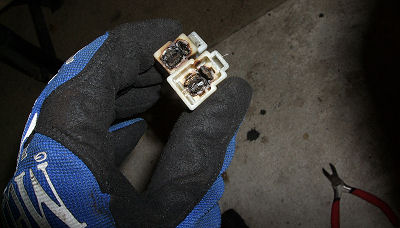
I joined the wires together with butt connectors (who thinks up these
names?) that come shrouded in shrink wrap. Add heat and Bob's your uncle, as
they say.
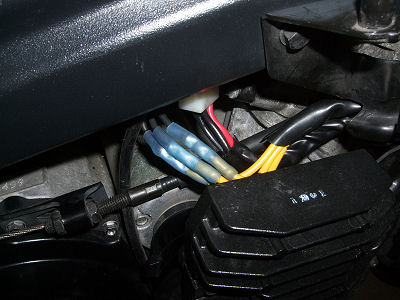
The new setup worked well and charging was restored to normal. Here's the
voltage with the engine revving at about 4K RPM.
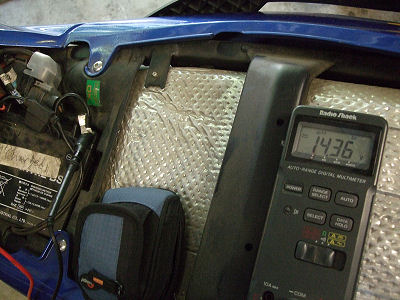
And so it continued for about a year and a half, until one morning I went
to start the bike and got nothing. I had recently replaced the battery and
just ridden it to work the day before, so I suspected another charging
problem. I put the battery on the battery tender overnight. The bike started
the next day, and when I put the meter on the battery, it showed charging up
to 16.6 volts at 6000 RPM - way too much. A peek inside the fairing revealed
ugliness.
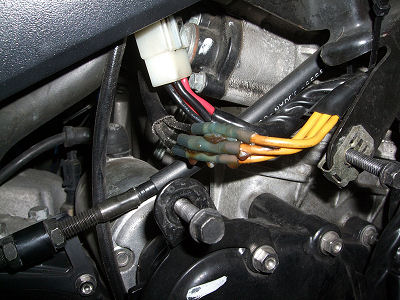
Since the battery showed high voltage that rose to overdose levels with engine speed, I knew
the stator was okay. We were still generating electricity. Since the wires connecting stator to R/R were
overheating, and since the voltage was way too high at the battery, I
suspected a failed R/R. The tests confirmed it.
There are three wires going into the R/R and four going out. To test it,
you connect each of the three wires to each of the four. You should not have
a short circuit to any of them. Here's the meter unhooked. The 0.L means
there is no connection and no resistance measured.
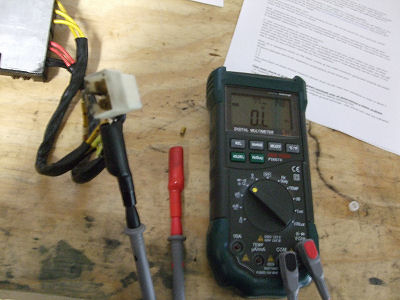
Here's one of the three hooked to one of the four.
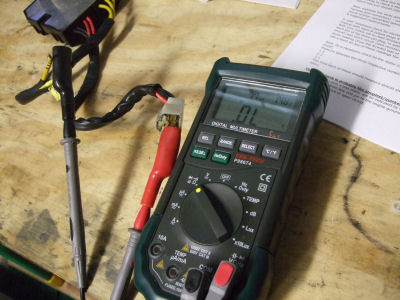
Same reading - which is as it should be. However...
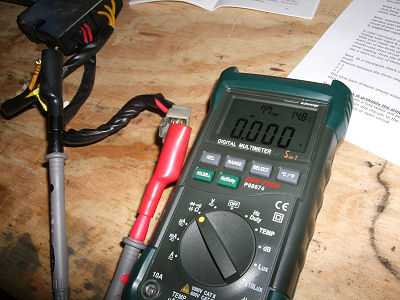
That different set of zeroes means we have a short circuit! A couple of
the connections were shorted, in fact. Time for a new R/R.
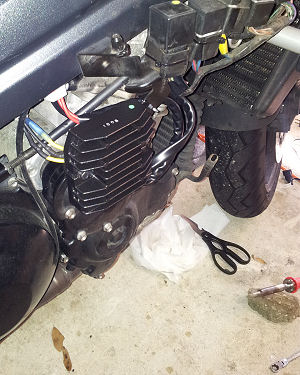
This time I went with soldered connections for two of the wires. With
everything back together, I'm reading a nice 14.3 volts at the battery,
instead of a cell-frying 16.6, so the regulating portion is doing its job.
At this point, I'm a little skeptical, but we'll see how long it lasts. If
it goes again, I'm going to just move the whole regulator assembly somewhere
cooler, away from the engine.

Return home
| 

